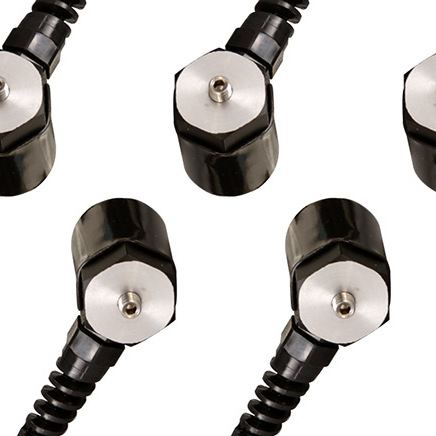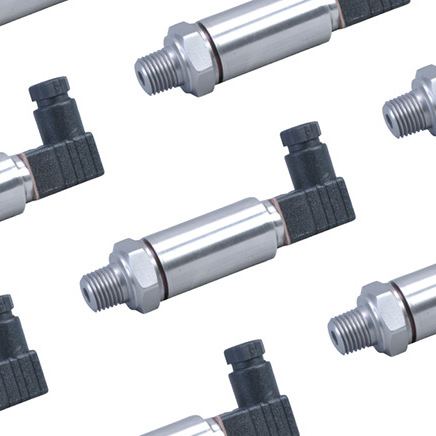The specifications section of a load cell data sheet lays out the key parameters and their significance.
Measuring Range
Load cell measuring range – or capacity of a load – is the difference between the lowest and highest load measurement the load cell can measure. Load cell measuring ranges differ depending on the type of load cell. When choosing a load cell for your application, it is important to determine the load cell measuring range. Every load cell manufacturer will provide information about the division range in a specification sheet to help you determine the minimum and maximum load measurement weight that a load cell can measure.Accuracy
Load cell accuracy is the difference between the measured value and the true value of the test subject. When the measured value deviates too much from the true value, the load cell will become inaccurate.Accurate measurement is dependent on numerous factors, such as:
- Temperature
- Creep
- Hysteresis
- Repeatability
Resolution
For a measuring device to show a change in output, it should first detect the change in its input. However, the ability of the measuring device to register that change depends on several factors. The resolution of a load cell is the smallest amount of force that can achieve a change in the output for a load cell. However, it is important to understand that selecting a load cell with a higher resolution doesn’t mean better results. It only means that the load cell will be capable of displaying the smallest measurement value. For applications where small weight changes are not necessary to record, a load cell with higher resolution is of no value.Accuracy vs Resolution
Load cell accuracy is the ability of the load cell to measure the force applied by an object to its true value. It is also the maximum difference between the actual voltage output and the theoretical voltage output of the load cell. The resolution of a load cell is the smallest change in the input that causes a change in output. In other words, the resolution is a degree to which the smallest change can be theoretically detected. In the case of load cells, the resolution is the smallest increment that the system can weigh. It is important to have a correct balance between accuracy and resolution when selecting the load cell. A load cell with higher resolution doesn’t necessarily mean that it will give accurate results. Similarly, a load cell with higher accuracy and lower resolution doesn’t necessarily mean that you will be able to record incremental changes in the weight.Sensitivity
Load cell sensitivity is the change in output in relation to the corresponding change in mechanical force input. Load cells with high sensitivity can measure even the slightest change inf the force. A typical analog load cell will have a load cell sensitivity rating in mV/V and is usually specified in the specification sheet in the 1 mV/V – 3 mV/V range. A load cell with higher sensitivity ratios is capable of detecting even the smallest change in loading conditions, resulting in an application with a faster response.Zero Balance Error
Zero balance is the output of the load cell at a no-load condition. It is usually quoted as a percentage of full scale and is also known as “zero offset”. The zero balance error check ensures whether the load cell has undergone a physical distortion due to overload, shock load, or metal fatigue. To perform this test, the load cell must be in a “no-load” condition. This means all the weight, including the dead weight, has to be removed. The signal leads are detached, and the voltage across +/- signal is measured using a millivoltmeter. The resulting output must be less than the manufacturer’s specification. Assuming a 10 volts excitation on a 3 m/V output load cell, the maximum signal for a 1% shift in zero balance is 0.3 millivolts.Linearity
A strain gauge load cell is designed to follow a linear relationship between the output voltage and the single load applied. However, this is idealistic and, ultimately, unrealistic. In reality, due to environmental condition and loading factors, the output will deviate slightly and is represented through a non-linearity curve. This curve represents the maximum deviation from a straight line - starting from zero load to maximum rate capacity. Non-linearity is also termed as linearity error and provides the load cell’s weighting error over its entire operating range. It is also possible to linearize the output using compensation circuits and microprocessors.Frequency Response
The load cell frequency response is the ability of the load cell to accurately respond to dynamic load changes. It is important to select a load cell with appropriate frequency response in situations where the weight is either applied or changes at a rapid rate. It helps the observer in optimizing the trade-off between load cell stability and response for a given frequency range. Frequency response is often designated as “bandwidth” in load cell specifications. As a rule of thumb, a load cell with a 10 times higher natural frequency than the highest frequency to be measured is generally selected.Input Voltage
The load cell input voltage (excitation) is the voltage sent to the input terminals of the load cell. Input voltage is necessary to enable the load cell to work because it is the source of the current that flows through the Wheatstone bridge inside the load cell. The maximum and recommended excitation values are usually provided by the manufacturer, which should be strictly followed to ensure the best output results.Excitation Voltage
To produce an output signal, strain gauge load cells require an excitation voltage. The maximum and recommended excitation voltage is often provided by the manufacturer. Maintaining these values is critical to ensure the best output results. An excitation voltage greater than the maximum rated value will increase the current flow and heat the strain gauge. It can even lead to gauge failure. A lower excitation voltage than the manufacturer’s recommended value is usually acceptable. However, for best results, it is best to stick to the recommended value.Life Span
Since load cells are made up of metals, the life of these measuring devices generally has a longer life span. However, each load cell has a specific fatigue life, normally provided in the form of cycle time. For example, if a load cell has a fatigue life of 100,000 times, the devices can be loaded 100,000 times. If the loading occurs more than the specified cycles, the load cells may not perform well as guaranteed in their specifications. Also, if the load cells undergo shock load – or if the force applied is more than their rated capacity for a longer duration – the life of these measuring devices gets shortened. With proper usage, maintenance, and protection, load cells can last for years.Orientation
Load cell orientation is about placing the weight in the right way onto the measurement setup. When the load cell is not installed properly – or if it is in an incorrect orientation – it would produce incorrect readings. Most load cells come with an arrow on its housing that denotes the direction of the load. When the load cell is installed correctly, the readings will be positive values. It is also important to verify that the load cell terminals are properly connected. Refer to the manufacturer’s color code guide to ensure that he load cell functions properly.- What is a Load Cell?
- Types of Load Cells
- Selecting a Load Cell
- FAQ
- Installing a Load Cell
- How to Wire a Load Cell?
- Troubleshooting
- Amplifiers for Load Cells
- Data Loggers for Load Cells
- Load Cell Meter
- Load Cell Controller
- Signal Conditioners
- Weighing Trucks, Trains, and Aircraft
- Dynamic Load Measurement
- Testing Load Tolerance in Cables
- Critical Component in X-ray Laser


